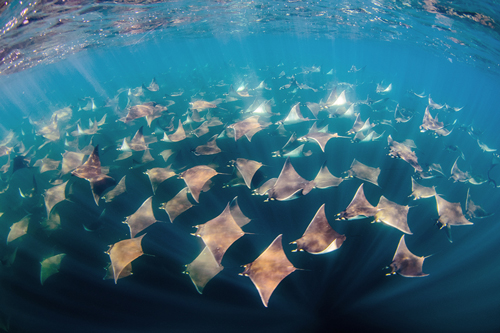
Pay your deposit and receive 5% discount on any cash balance payments, contact the office for info.
Cabo San Lucas whale watching tour
Every year from December 15 to April 15 Los Cabos witnesses the incredible migration of humpback whales from Alaska and Canada. These beautiful animals arrive in warmer climes to engage in mating behaviour and to birth their young. Take a two and a half hour tour on a fast, comfortable panga (or upgrade to a luxury boat?) out into the Sea of Cortez and find families of humpbacks breaching, jumping and slapping at the surface. Occasionally grey whales, orcas and blue whales are spotted.
There will be drinks and snacks for the duration. You can choose an early morning tour, late morning or afternoon tour.
Tour details Price & booking
Tour Outlines
You might be wondering what goes on on your whale watching tour? How do we find the whales and what can you expect to see? Not long after the sun comes up, Humpback whales start to play!
What's included
- Private guide
- Private Panga boat Options : Yachts and Luxury Vessels
- Water and Snacks
Schedule
Every day
Departure
From Cabo San Lucas Marina
Duration
2 and a half hours
Price & Booking
Whale watching in Cabo
Price in USD | Cash discount availablePrivate Panga Boat
$ 650 price per boat
1- 8 people | 5% Cash Discount
Included
Private Panga Boat
Private guide
Water & Snacks
Duration
2 and a half hours
**Excludes booking fees
Variable prices
Yachts and Luxury Vessels
If you’re looking for a more luxurious way to experience whale watching in Cabo San Lucas we invite you to browse our yacht catalogue.
Choose from a selection of yachts, sailboats and catamarans with all-inclusive food and drink menus.
5% discounts available on balance Payment. Contact us to leave a deposit
Secure online payement powered by wetravel.com
To see the prices in your local currency, click the "Book Now" button
Humpback Whale Behaviours
Humpback Whale can be spotted as they come up to breathe and their breath disperses water from their blowhole. When it’s time to dive deep their tail, ‘or fluke’ , is easily seen. If you’re lucky enough to see the underside then you are seeing their ‘fingerprint’. This pattern is how citizen science organisations such as www.happywhale.com identify individuals.
The most exciting behaviours are breaching, fin slapping and head slapping! Breaching is when whales launch themselves out of the water. Why do they do this? There are a number of theories: the first is because they like to attract attention by making a loud noise, either to warn off competition or gain attention.
We see mother and baby doing it too, so the mother is thought to be playing and teaching her offspring!
Why do the humpback whales come down to Cabo?
What makes this place so popular with the whales? Well that’s easy!
Los Cabos is on the tip of the peninsular; at the gateway to the Sea of Cortez which is known to be one of the most biodiverse seas on the planet. Not only this, but many whales species treat the Cortez like an ocean nursery away from the vast and open Pacific Ocean.
Baja California waters are better suited to newborns and when it’s time to mate and give birth they travel south for the warmth and protection that it provides. The feeding grounds in Alaska and Northern Canada are very cold and the baby must be nursed to strength on the journey home.
The mother will not feed during this time. During the whale watching season, which runs December 15 – April 15, you are likely to see many young whale playing on the surface with their mother as she teaches them how to breach, fluke and head slap: behaviours necessary for attracting a mate when they grow into adolescence.
Price & booking
















